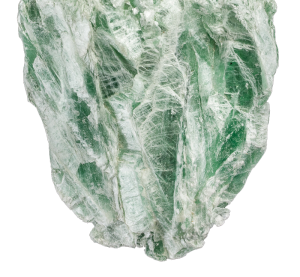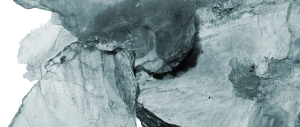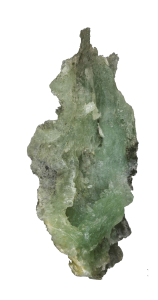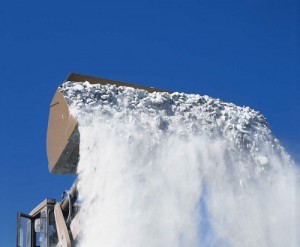Chemical Formula: Mg3Si4O10(OH)2
Composition: Molecular Weight = 379.27 gm
Magnesium 19.23 % Mg 31.88 % MgO
Silicon 29.62 % Si 63.37 % SiO2
Hydrogen 0.53 % H 4.75 % H2O
Oxygen 50.62 % O
______ ______
100.00 % 100.00 % = TOTAL OXIDE
Empirical Formula: Mg3Si4O10 (OH) 2
Environment: Hydrothermal alteration of non-aluminous magnesian silicates.
IMA Status: Valid Species (Pre-IMA) 1546
Locality: Common world wide. Link to MinDat.org Location Data.
Name Origin: From the Arabic.
Name Pronunciation: Talc Say TALC
Synonym: Kerolite
Magnesium Talc
Soapstone
Steatite – massive
Talc
Talc is used in many industries—including paper making, plastic, paint and coatings, rubber, food, electric cable, pharmaceuticals, cosmetics, and ceramics. A coarse grayish-green high-talc rock is soapstone or steatite, used for stoves, sinks, electrical switchboards, crayons, soap, etc. It is often used for surfaces of lab counter tops and electrical switchboards because of its resistance to heat, electricity and acids. Talc finds use as a cosmetic (talcum powder), as a lubricant, and as a filler in paper manufacture. Talc, with heavy refinement, has been used in baby powder, an astringent powder used to prevent rashes on the area covered by a diaper. The American Academy of Pediatrics recommends that parents not use baby powder because it poses a risk of respiratory problems—including breathing trouble and serious lung damage if the baby inhales it. The particles are so small that it is difficult to keep them out of the air while applying the powder. Zinc oxide-based ointments are a much safer alternative.
It is also often used in basketball to keep a player’s hands dry. Most tailor’s chalk, or French chalk, is talc, as is the chalk often used for welding or metalworking.
Due to its low shear strength, talc is one of the oldest known solid lubricants. There is also a limited use of talc as friction-reducing additive in lubricating oils.
Talc is widely used in the ceramics industry in both bodies and glazes. In low-fire art-ware bodies it imparts whiteness and increases thermal expansion to resist crazing. In stoneware, small percentages of talc are used to flux the body and therefore improve strength and vitrification. It is a source of MgO flux in high temperature glazes (to control melting temperature). It is also employed as a matting agent in earthenware glazes and can be used to produce magnesia mattes at high temperatures.
- Ceramics
Talc improves the mechanical and optical properties of floor and wall tiles& ceramics, and allows producers to cut energy costs. It helps in the production of large-format ceramics.
In refractories, chlorite-rich talc forms cordierites at lower temperatures and with higher thermal shock resistance than magnesite-based cordierites.
Talc is the principal ingredient in the catalytic convertors and diesel particulate filters used to filter emissions on today’s cars.
- In paints & coatings
Talc is an ideal pigment, filler and extender in house and industrial paints and primers, where it improves mechanical and optical properties and production processes.
It brings a range of benefits to color concentrates, inks, enamels, varnishes, putties, body fillers, mortars and asphalts.
- In paper
Talc is used in the pulp, paper and board industry as a filler and to control pitch and stickies which clog machines impacting run ability.
Talc is an effective coating agent in rotogravure and offset papers where it improves run ability and the quality of the finished paper.
In certain specialty papers such as colored papers and labels, ADT talc’s special properties improve quality and productivity.
- In plastics
Talc is an excellent reinforcing filler in polypropylene and engineering thermoplastics for automotive parts, domestic appliances, E&E components and food packaging.
It is used for anti blocking in polyethylene; restores mechanical properties to recycled plastics; and is an ideal nucleating agent in bio polymers and semi-crystalline polymers.
Talc is added to wood-plastic composites – increasingly used as a sustainable substitute for lumber in outdoor decking – to improve structural integrity.
- In rubber
Talc is used in seals, hoses, membranes, cables, tires and other mechanical rubber goods to improve processing, permeability, weathering, electrical properties, fire resistance and mechanical properties such as tear.
In tires, high aspect ratio Talcs improve the impermeability of inner liners, improving rolling resistance and contributing to better fuel efficiency.
- Talc can soothe dry skin and treat eczema
Talcum powder can work like a moisturiser to help soothe extra-dry skin. If you have areas of irritated skin, rub a bit of talcum powder in to calm it.
Keep it on hand throughout the summer and winter months when your skin tends to get really dried out
Talc can thicken your eyelashes
Dust them with talcum powder before you apply mascara. The powder acts as a primer which gives you fuller, longer-looking lashes.
- Use talc to set your make-up
Talc can absorb and remove facial oils, acting as a primer to help set your makeup for the day or night and prevent you from looking too shiny. Talcum powder can also be mixed with a powder or bronzer that is a bit too dark to lighten it up.
- Talc can prevent chafing
On a hot summer’s day or before you begin exercising, try dusting some talcum powder between your thighs to prevent chafing. It will help to eliminate friction when you run so your skin will stay smooth and pain-free avoiding the risk of sores.
- Use talc to wipe away sand
There’s nothing more frustrating than applying sun cream to parts of your skin covered in sand, so sprinkle the powder on areas that have sand stuck to you and wipe off.
The sweat, oil and water that’s causing the sand to stick will be absorbed by the powder meaning the sand can be easily wiped off your skin. Better still, you’ll know your car and house won’t turn into a sandy mess either.
- Use talc instead of dry shampoo
Sprinkle some talcum powder underneath the top layer of hair at your roots to absorb excess oil.
If you have dark hair, mix the powder with cocoa powder and for red hair, mix in some cinnamon. Gently brush through to evenly distribute the product evenly and no-one will ever know!
- Use talc to cool your sheets
During a hot summer’s night, sprinkle some talcum powder on your bed sheets before heading to sleep and you’ll feel cool and dry all night long.
- For silky smooth legs
After exfoliating, apply talcum powder to the area of skin you’ll be waxing before you begin. It will absorb any excess oil on the skin’s surface so the wax will be able to grab your hairs better. Better still, your skin will be soothed by the cooling effect of the powder.
- Talc helps to freshen up your wardrobe
If your wardrobe is smelling a bit musty – guess what? You can freshen it up with talcum powder.
Sprinkler a small amount of talc into a jar or dish and leave it in your wardrobe. The moisture removing properties of the powder will keep it free from that musty smell. You can also you can use it to freshen up your carpets as well. Sprinkle a light covering on your carpets, let it sit for about 15 minutes and then hoover up – this works wonders for removing tough smells, such as pets or cigarettes.
- Use talc to stop shoes from smelling
If you or someone in your house has smelly shoes, talcum powder works wonders to eliminate the smell in your hallway.
Simply sprinkle a light dusting of talcum powder inside the shoe and leave them overnight. In the morning, shake out the baby powder and you’re good to go. Try this tip with your trainers before you go to the gym too, and the powder will absorb any sweat leaving your shoes smelling fresher.
why you choose ADT CO. Talc?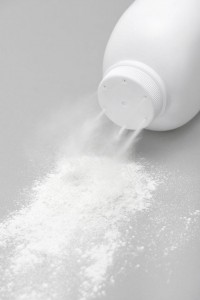
High whiteness & brightness
High purity
Free from Asbestos and heavy metals
suitable price.

